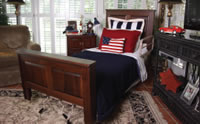Addressing the Emotional Needs of Mobility Patients
There are many companies that address the medical needs of a bed-bound patient. They provide state-of-the-art equipment that adjusts height, position, legs, and upper body — but they don’t address the emotional needs of the patient.
That’s where TenderCare Beds come in.

TenderCare Beds’ footboards, headboards, and other furnishings, such as such as nightstands and foot chests, turn a patient’s room from one that would otherwise feel clinical or “sick” into a warm and inviting living space.
“When a person is in the unfortunate position of needing a hospital bed, they are delivered a standard, institutional looking bed,” says Greg Verlander, principal of TenderCare Beds. “Until our patent-pending product, they had no choice but to live with the way it looked. Our company addresses the emotional impact that an institutional bed has on the patient. We make hospital beds beautiful.”
Verlander shares how the concept came to be:
“Our product was invented out of necessity,” he says. “Our inventor’s wife came down with a debilitating illness, which required her to be confined to a hospital bed. Her life was reduced to one room. With institutional furniture and equipment filling her room, she became depressed. So much so that she did not want visitors to come see her. She was embarrassed to be seen in a hospital bed. When the source of her embarrassment was identified, the idea to make the hospital bed look like a normal bed was born.”
TenderCare Beds makes headboards and footboards that help transform the look of a hospital bed. “No longer does a person have to be content with an ugly, institutional looking bed,” says Verlander. “With our headboards, footboards and other auxiliary products such as nightstands and foot chests, the patient can have a great looking, normal room.”
Verlander offers the following tips to make the “sick” room as warm and inviting as you would a normal room: “There are many pieces of equipment needed to provide services, but try to visually reduce those as much as possible,” he suggests. “Our headboards and footboard are perfect to make the bed look normal. Our nightstands are large and can hold a lot of equipment when the equipment is not in use. Our foot chests are perfect for the end of the bed to store towels, sheets, or wound care items. You want the patient to feel as if they were in their own bed and environment. This can be done with some fore thought, even when your life shrinks to a single room.”
This article originally appeared in the September 2010 issue of HME Business.